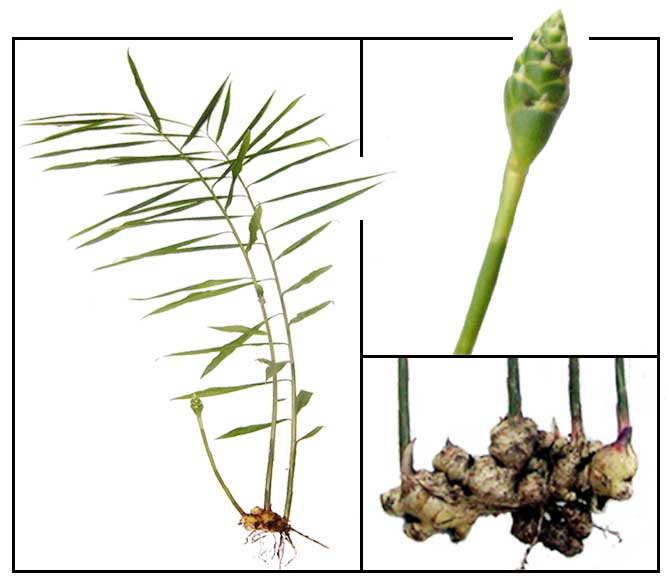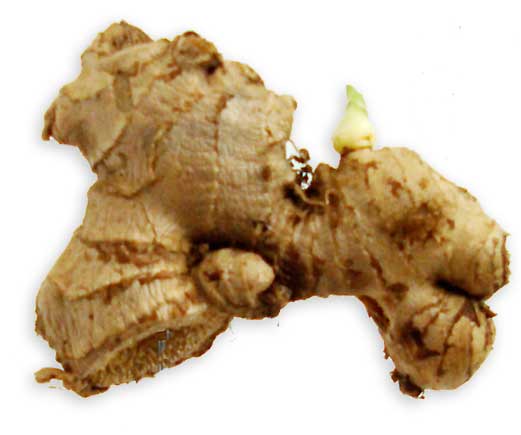| Other scientific names | Common names |
| Amomum zingiber Linn. | Agat (Pamp., Pang.) |
| Zingiber blancoi Hassk. | Baseng (Ilk.) |
| Gengibre (Span.) | |
| Laial (Sbl.) | |
| Laiya (If.) | |
| Laya (Ilk., Bon., Ibn., It.) | |
| Luy-a (Bis.) | |
| Luya (Tag.) | |
| Chiang-t'i (Chin.) | |
| Ginger (Engl.) |

| Botany Erect, smooth plant with thickened and aromatic rootstocks. Leafy stems are 0.4 to 1 meter high. Leaves are distichous, lanceolate to linear-lanceolate, 15-25 cm long, and 2 cm wide or less. Scape from rootstock is erect, 15-25 cm high, covered with imbricate bracts. Calyx is 1 cm long. Corolla is greenish-yellow with a tube less than 2 cm long.  Distribution DistributionWidely cultivated in the Philippines. Parts utilized Tops, leaves and edible roots. Constituents • Pungent principles, mainly zingerone and shogaol, provides the characteristic taste. • The most biologically active phenolic compounds, gingerols and shogaols, are found in the root. • Volatile oil, 1.23 to 3% - gingerol, zingerone, zingiberene, cineol, borneol, phellandrene, citral, zingiberene, linalool, geraniol, chavicol, vanillyl alcohol, camphene; resin. Properties • Extracts and active constituents have shown potent antioxidant, antiinflammatory, antimutagenic, antimicrobial and possible anticancer activities. • Considered adaptogenic, anodyne, anthelmintic, antiallergenic, antibacterial, anticoagulant, anticonvulsant, antidepressant, antifungal, antithrombotic, antitumore, antiulcer, aphrodisiac, carminative, diuretic, rubifacient, anti-platelet aggregation, hypolipidemic, thermoregulatory. Uses Nutritional Flavoring for ginger ale, ginger beer, and other beverages. Salabat, a native beverage, is prepared from the rhizomes. A prominent condiment in Filipino cuisine. Taken with rocksalt before meals is cleansing to the tongue and throat and increases the appetite. Folkloric Antiseptic: Prepare tincture of dried rhizome with 70% alcohol (not rubbing alchol) and apply on superficial cuts and wounds or use juice from fresh rhizome. As digestive aid and for flatulence and tympanism: Take decoction of the rhizome as tea. Rheumatism: Pound roasted rhizome, mix with oil and apply locally. Sore throat and hoarseness : Take warm decoction of the rhizome as ginger tea (salabat) or chew a small piece of rhizome. Cough remedy and carminative. Diuretic. Hangovers. Headaches: Ginger plaster (bruised ginger in water to the consistency of poultice) applied to the forehead. Same preparation may be helpful for toothaches and facial pain. In Ayurvedic medicine, used for inflammation and rheumatism. In Chinese folk medicine, pulverized fresh ginger used for baldness and vitiligo. Juice from fresh root used for treatment of burns. New uses • Motion Sickness / Pregnancy-related Nausea: Antiemetic properties. Used for Nausea, motion sickenss (1 gm taken 1/2 hour before the voyage). Stimulates digestion. Possibly antiinflammatory. Preparations • Ginger tea Ginger tea preparation, the Chinese way : Bring one cup of water to boil. Add one teaspoon of the roasted (parched and browned) rice and a small piece of ginger root. Boil for one minute. Let stand to cool for drinking. (Preparation of dried rice: Pour enough water to cover 1/2 cup white rice in a flat dish; and let stand overnight. In the morning, drain off the excess water. Roast the rice in a dry pan, stirring constantly until parched and brown. Store in a glass jar for future use, tightly covered to keep moisture out.) • Ginger lozenges • Wash and peel the ginger, then mince. • Spread and air-dry for a day or oven-dry at 250 C. • Grind and strain the dried ginger. * In a mortar, mix 1 cup ground giner and 1 cup confectioner's sugar. • Pound and mix while gradually adding water until a pulp is formed. • Level the pulp on a board lined with wax paper. • Using a mold, make balls from the pulp and wrap each lozenge in aluminum foil. How to make medicated candies from powdered rhizomes Materialls, proportion and procedure Go to Traditional and Modern Medicine http://traditionalmed.blogspot.com/2007/01/how-to-prepare-ginger-lozenges.html Studies • Prokinetic: Pharmacological basis for the medicinal use of ginger in gastrointestinal disorders: Study confirmed prokinetic activity of the extract. Spasmolytic constituents may explain its use in hyperactive states as in colic and diarrhea. • Antidiarrheal: Study results indicate that in the absence of antimicrobial action, Z officinale exhibits its antidiarrheal activity by affecting bacterial and host cell metabolism. • Antibacterial: Antibacterial Activity Of Allium cepa (Onions) And Zingiber officinale (Ginger) On Staphylococcus aureus And Pseudomonas aeruginosa Isolated From High Vaginal Swab: Thes study showed both plant had antibacterial activity on the test organisms, ginger having more inhibitory effect, and confirming their folkloric use. • Antiinflammtory / Anti-thrombotic: The use of ginger (Zingiber officinale Rosc.) as a potential anti-inflammatory and antithrombotic agent: Study suggests ginger can be used as a cholesterol-lowering, anti-thrombotic and anti-inflammatory agent. • Antioxidant / Anticancer: Study showed Zingiber officinale may exert its anticancer effect by replacing the action of superoxide dismutase, glutathione peroxidase and catalase in removing superoxide radicals and hydrogen peroxide causing oxidative damage to cells. • Antibacterial (Garlic/Ginger) Synergism: Study investigated the therapeutic effects of ginger and garlic against Klebsiella pneumonia, whether the combined extract could be synergistic or antagonistic in rats. Study showed a synergistic relationship, garlic ameliorating the efficacy of giner only against Klebsiella infection. • Anti-Inflammatory / Anti-Arthritis / Prostaglandin Inhibition: Study suggests one of the mechanisms by which ginger shows ameliorative effects could be through inhibition of prostaglandin and leukotrine biosynthesis - as a dual inhibitor of eicosanoid biosynthesis. • Gastroprotective: Study results suggest cytoprotective and anti-ulcerogenic effects with significant protection against ethanol-, HCl-, NaOH-induced gastric lesions and prevention of the occurrence of gastric ulcers induced by non-steroidal anti-inflammatory drugs and hypothermic restrain stress. • Decreased Sperm Motility: Study results conclude that ginger can induce toxic effects on sperm parameters, ie, a lower percentage of motility and grading when methanolic ginger is added to semen fluid. • Hepatoprotective: Study of the ethanol extract of Z officinale showed protective effect against paracetamol-induced hepatotoxicity with better protective effect at higher dose levels. • Anti-Aging: Study in mice showed ginger extract significantly reduced the development of atherosclerotic lesions and lowered LDL-cholesterol. • Anti-Inflammatory / Analgesic: Study of rhizome extract in Swiss mice showed anti-inflammatory and analgesic properties with significant inhibition of carrageenan-induced paw edema and reduction of writhing induced by acetic acid. • Pregnancy-Related Nausea: Reasonable evidence suggests that ginger roots is effective in reducing pregnancy-related nausea. However, there is conflicting data on its efficacy for preventing motion sickness or post-operative nausea. • Anti-Inflammatory / Antibacterial / Hypoglycemic / Analgesic: Study of ethanol extract showed (1) reduction of carrageenan-induced paw swelling and yeast-induced fever (2) blood glucose lowering (3) inhibition of gram- and gram+ bacteria (4) dose-dependent prostaglandin release inhibition. • Analgesic: Study demonstrated the daily consumption of raw and heat-treated ginger resulted in moderate to large reduction in muscle pain followoing exercise-induced muscle injury. The findings agree with findings of ginger's hypoalgesic effects in osteoarthritic patients. • Antiarthritic: Study of the alcoholic extract of ZO can ameliorate inflammatory processes in rat collagen-induced arthritis, together with reduction of serum levels of interleukins, TNF, and anti-CII antibodies. It also showed to be superior to indomethacin 2 mg/kg/d at most measured parameters. The extract presents an alternative to NSAID use in RA. Side effects • No known side effects or drug interactions. • The German Commission E recommends that it be avoided during pregnancy due to possible inhibition of testosterone binding in the fetus. • The use in pregnancy for hyperemesis gravidarum is controversial. Use for nausea during pregnancy is not recommended. • Should not be used by pregnant women with a history of bleeding disorders and miscarriages. Anticogulang precaution Decreases platelet adhesiveness; therefore, should be used with caution by patients on anticoagulant therapy. Availability Wild-crafted. Popular condiment and perennial market produce. Candied ginger and lozenges. Dried powdered gingeroot. Tinctures, tablets, capsules, syrups and teas in the cybermarket. |
No comments:
Post a Comment